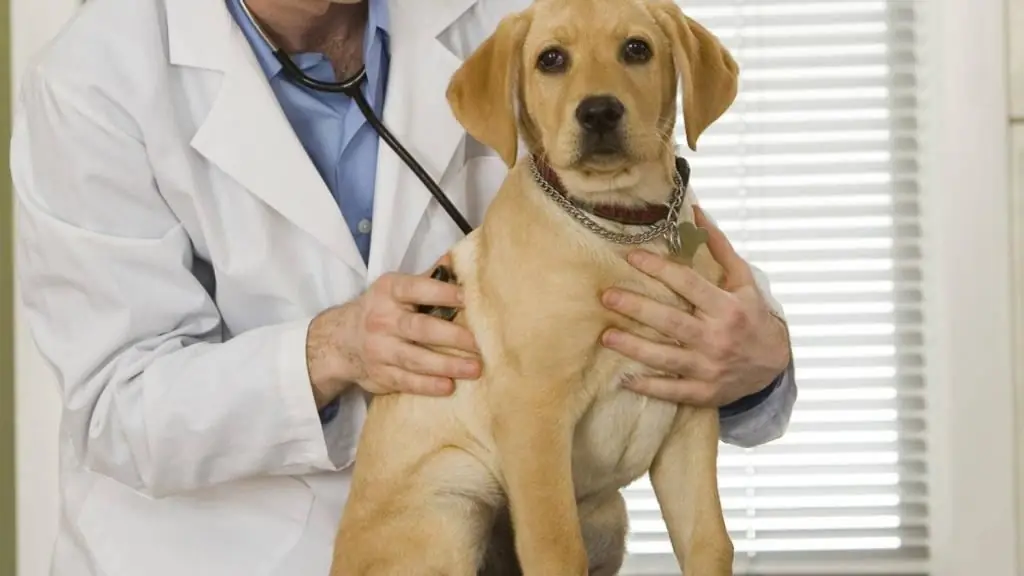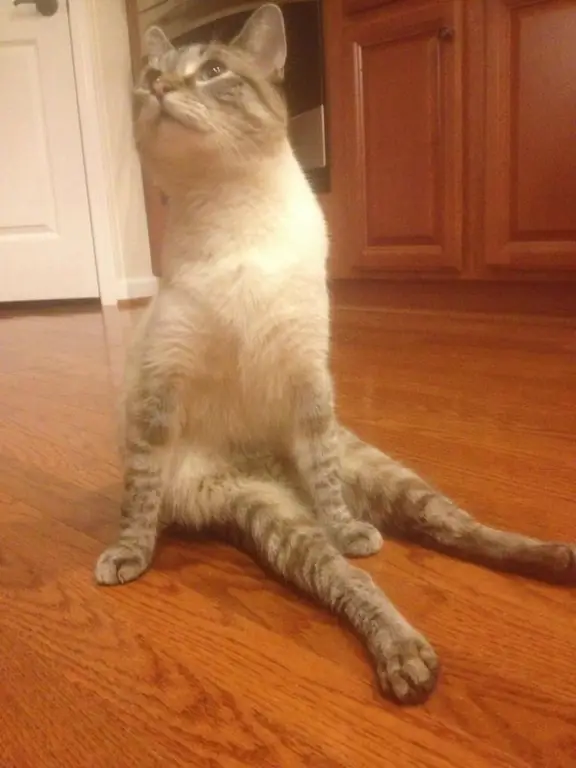2026 Author: Priscilla Miln | [email protected]. Last modified: 2025-01-22 17:55:23
Often, owners turn to the veterinary clinic, complaining that the dog's hind legs are being taken away. Each of them describes the symptoms in their own way: the pet is limping, hunching its back, dragging its paws, it is paralyzed.
Introduction

There is no single reason that can cause such symptoms. Canine veterinary science suggests that the first step in treatment should be a qualified diagnosis. To know how to treat, you need to know what to treat. And without a trip to the veterinarian, you can’t do it here.
Some pathologies, when a dog's hind legs are taken away, include age and breed predisposition. So, pugs, poodles, English and French bulldogs, dachshunds and Pekingese have a predisposition to the destruction or displacement of the intervertebral discs (herniated discs).
Discopathy
This pathology is quite serious and can pose a threat to the life of a pet. As the disc moves, it compresses the spinal cord. Outwardly, this will be manifested by periodic bouts of severe pain: the pet freezes in one position (usually with a hunched back andoutstretched neck), shortness of breath, severe trembling, hind legs weaken and give way.

The reasons why dachshunds experience a decrease in the strength of the intervertebral disc, scientists have not fully identified. A genetic predisposition has been established in some lines of breeding dogs. Due to the mutual pressure of the vertebrae on each other, the gelatinous nucleus pulposus moves into the thickness of the fibrous ring and subsequently leaves its limits, falling into the paravertebral space. The fibrous ring has the lowest strength on the side of the passing spinal canal, and therefore parts of the destroyed disc are usually displaced in this direction. This causes compression of the spinal cord lying here, as well as its nerves.
If the compression of the spinal cord is not so pronounced, then clinically it will manifest itself only in this way - the dog's hind legs have failed. The pet drags them, tries to transfer the weight of the body to the forelimbs. He tries to jump onto a chair (sofa, armchair), but he does not succeed. Can't bend over to the floor, bowl. If there is a suspicion of discopathy, you need to go for a qualified diagnosis and prepare for treatment, up to surgery. Compression of the spinal cord can cause irreversible changes in the body, when therapeutic measures are simply ineffective.
Dysplasia

In pets of giant and large breeds (Labrador, Newfoundland, Rottweiler, Great Dane, St. Bernard, German Shepherds 4-12 months fromgenus) also have their own predispositions to the disease when the dog's hind legs fail. This is a lesion of the hip joints (dysplasia). Many things can affect the occurrence of this pathology: heredity, slippery floor, overweight puppy, unbalanced diet, etc.
Causes of dysplasia
There have been many scientific debates about the causality of this disease. And so far, two theories have been formed about the heredity of this pathology and the mechanism of inheritance.
Many geneticists favor the theory of additive inheritance. That is, the disease develops due to the action of genes that are involved in the final formation of the hip joint.
The second theory is based on the premise that these same genes influence each other, and their interaction is combined in various ways. This means that the defect has a much more complex hereditary nature than shown by the first theory.
There is a third theory in the world of geneticists. It combines the first two. According to it, the action of the genes responsible for the creation of joints can be summed up, and individual genetic pairs affect each other in different ways.

The general conclusion of experts: the disease is a classic example of a quantitative trait, which is influenced by many genes (polygeny), and in this case, many environmental factors exert their influence on the final formation and manifestation of traits. The clinical manifestation of dysplasia, when the dog's hind legs are taken away, is not present in all animals. Butthis does not mean that a pet at risk is not susceptible to this pathology if there are no pronounced symptoms. When choosing a mating partner, the pedigree should be examined for the presence of ancestors with dysplasia. It should be noted that the disease can be transmitted to descendants through fourteen generations.
Swedish canine veterinary medicine has unequivocally proved that dysplasia is associated with heredity and is inherent in certain breeds. And if the breed is characterized by a powerful physique and large mass, then the probability of the disease is very high. The hip joint in a dog carries a huge load. It gives the body when moving the pushing force from the hind limbs. And during this push, the joint is extended and holds the head of the femur along the entire acetabulum. Particularly great friction occurs in the joint when the animal, standing on its hind legs, jumps or walks.

If the hip joints are affected, then the weakness of the hind legs will appear immediately after the rest period (when getting up in the morning) and decrease with physical exertion. Also, this lesion is rarely symmetrical, the dog will begin to "fall" on only one paw.
Myositis
Middle-aged dogs can develop inflammation of the muscles, called myositis, after too much exercise the next day. As a result of overvoltage, tear, rupture, separation of muscle fibers and hemorrhage into the thickness of the muscles can occur. Due to damage, traumatic edema develops, and with a significant rupture of muscle fibers, a scar forms, and the muscle shortens. This leads to myogenic contracture of the corresponding joint. If pathogenic microflora gets into the affected muscle, purulent myositis will develop.
One of the symptoms of this disease will be "stilted gait" or weakness of the hind limbs, the dog limps on the hind leg. Treatment of dogs with such an ailment will not cause great difficulties, but only a veterinarian can distinguish myositis from other diseases.
Osteochondrosis
Another disease that can cause a pet to have problems with its hind legs. The main reason is a violation of cartilage mineralization. Typical for puppies of large breeds. Osteochondrosis is a multifactorial disease. Nutrition and genetics play key roles. The stratification of cartilage with such a pathology is more often observed in the joints subject to the greatest load (hip). The result will be the appearance of lameness, the dog limps on the hind leg.
Fractures

This pathology is common among puppies of large breeds. And many owners cite trauma as the cause. The dog tightens its hind leg, cannot lean on it. Reacts painfully to touch. In most cases, fracture occurs with minimal impact from the outside. This type of injury is called a pathological fracture and indicates a low mineralization of the skeleton. Causes - low intake of calcium or vitamin D, high intake of phosphorus.
For recovery in this case, it is not enough to fix the fracture. The main thing is to prescribe the right diet. The best option is to use ready-made feed,balanced in phosphorus, calcium, vitamins D and A. An excess of these substances will delay bone healing.
Old age
An older dog falls on its hind legs? This may be due to a malfunction of the brain. According to the observations of veterinarians, this is most often due to various vascular problems, less often - the cause is the presence of brain tumors. Proper treatment in this case can significantly improve the well-being of the pet and prolong his life for years.
What should be distinguished from

Kidney problems cannot cause a dog to lose its hind legs and develop a hunched body if the pet does not have an extreme degree of exhaustion with autointoxication. But in this case, weakness will spread to the entire muscular apparatus.
What not to do
The most common mistake owners make when detecting weakness in the hind limbs is self-treatment of dogs with non-steroidal anti-inflammatory drugs (diclofenac, indomethacin, aspirin, etc.). The clinical improvements observed by the owners after the use of these drugs are only temporary, but they hide the underlying disease well, which greatly complicates the correct diagnosis of the disease, due to which the dog's hind legs are taken away. Also, medical anti-inflammatory drugs carry a number of serious side effects for pets, including ulcers on the walls of the stomach and bleeding in it.
Recommended:
How to fatten a dog? How and what to feed a malnourished dog? Wet dog food

Pet dog owners often wonder how to help their pet gain weight. Severe thinness may be the result of a serious illness or other reasons. How to feed a dog? This process is not fast and requires compliance with certain rules
When can a kitten be taken away from a cat, at what age?

When a decision is made to get a furry pet, the question arises: when can a kitten be taken away from a cat. The answer will be given in the article
Dog behavior after spaying: character change, dog care after spaying, pros and cons of dog spaying

Every animal needs love and affection, as well as the full satisfaction of natural needs. That is, the availability of food and water, the opportunity to walk in the fresh air, get to know relatives and breed. It is the latter question that is often the most acute. It's one thing if your pet is a show winner and there is a queue for puppies. And it’s completely different if it’s an ordinary mongrel. In this case, sterilization will be a good solution to forget about the problem of adding offspring forever
Papillon dog. Papillon (dog): price. Papillon dog breed: photo

The Papillon dog is a representative of an ancient decorative breed. Its history spans over seven hundred years. There are several versions of the origin of this species. According to one of them, the birthplace of these dogs is Spain, and according to another, Belgium. Unfortunately, there is no exact data on the place of origin of the breed
Cat's hind legs are taken away: causes, symptoms, diagnosis, veterinarian consultation and treatment

Yesterday your furry pet was merrily running after the ball, but today he can't move on his own? This situation, unfortunately, is familiar to many pet owners. But why do cats lose their hind legs? The reasons may be different. The most common and will be described below

